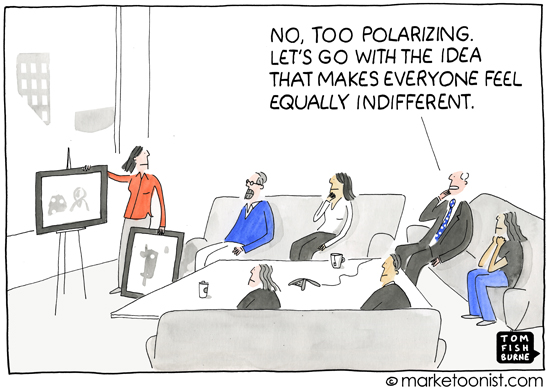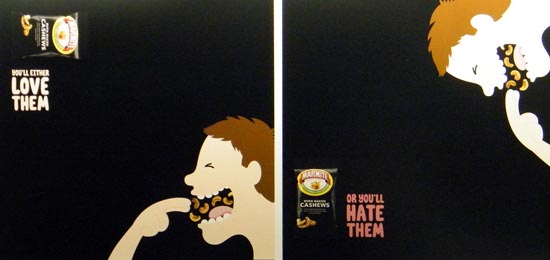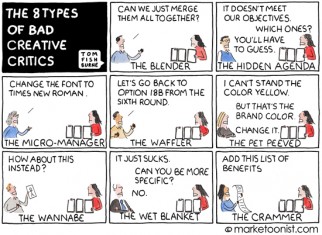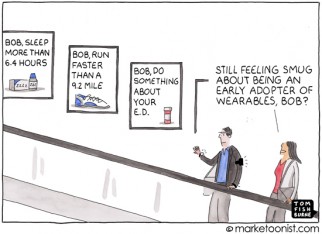Labeling an idea polarizing can be the marketing kiss of death. Businesses often avoid ideas that are polarizing, whether new products, ad campaigns, or promotions. It’s always easier to launch the next flavor of vanilla.
But there’s power in polarization. If you try to appeal to everyone, you won’t necessarily appeal to anyone in particular. In a world of clutter, the last effect a brand can afford to create is indifference.
The poster brand of polarization is Marmite, the classic yeast food spread in the UK. Their brand platform is literally, “love it or hate it,” an insight they’ve been tapping for 20 years.
Many product categories turn into a sea of sameness over time. But you can’t out-vanilla vanilla. There’s opportunity in many categories to take more of a Marmite approach to marketing.
I like this quote from Guy Kawasaki:
“Don’t be afraid to polarize people. Most companies want to create the holy grail of products that appeals to every demographic, social-economic background, and geographic location. To attempt to do so guarantees mediocrity. Instead, create great products that make segments of people very happy. And fear not if these products make other segments unhappy. The worst case is to incite no passionate reactions at all, and that happens when companies try to make everyone happy.”
I’d love to hear your thoughts on the polarization in marketing.
(Marketoonist Monday: I’m giving away a signed cartoon print. Just share an insightful comment to this week’s post by 5:00 PST on Monday. Thanks!)





Neil says
A very timely topic for us! We’re currently re-energising one of our your beauty brands that has razor sharp focus on a young female demographic. The team behind the project, (myself included) are a mixed bunch of male, female, young, middle aged and more mature with different income levels.
Such is the temptation to choose a creative direct direction that all of the above team ‘like’, that we run the risk of creating something that appeals in a soft and apologetic manner to us all…but ignores the only person that matters – the customer!
Bold decisions ahead!
Charlie Snell says
Spot on as ever! Try to appeal to everyone, and you’ll be everyone’s third choice! In short you’ll end up in No-Man’s-Brand!
BasisPoints says
The latest trend in nipping good, polarizing ideas at the bud seems to be the term “scalability.” While this doesn’t apply as strongly to advertising, when it comes to every other stage of the process, from product design to marketing channels, any good idea that will resonate with a segment is turned down when it is deemed unsuitable for the entire user/customer population.
It’s scary how top brass don’t even seem to understand the equivalency. They will continually request bold ideas, consistently mention the need for differentiation, and insist they don’t want vanilla – but when an idea is strong, and initial tests even yield incredible results, these initiatives are killed when they won’t “scale.”
If the litmus test for scalability is appealing to everyone, then you’re automatically in conflict with the the concept of differentiation. You’d think folks with T10 MBAs would remember Porter’s generic strategies – and that if we’re not the price leader (and no, we’re not Walmart), you must differentiate and focus. The result? Guess I’ll just put another 10% offer on a Twitter Bootstrapped website, but this time put it in an email sent to a different demographic
Nathan Hirst says
Great article. I’ve been teaching this concept in a marketing class I teach, but have been using this article (http://slatestarcodex.com/2014/12/17/the-toxoplasma-of-rage/). I think I’ll switch to this much more positive version of the same concept.
Chet Frame says
We need look no further than the Donald Trump campaign. Love it or hate it, he is getting all of the coverage to this point.
BC says
Being distinctive with a bold claim is going to get attention but there’s a fine line between polarization and alienation… The good news is we have all developed attention spans and memories measured in microseconds — bad today, forgotten… today!
Steve Garvin says
As a small business owner, I have come to the conclusion that unless you have the marketing budget of Coca Cola or the like, the vanilla approach is too costly in both time and money.
At the same time, it is often scary to be polarizing. I–like pretty much everyone I know–want to be liked. Being distinctive is the right choice, but I can understand why people (including myself) fall into the vanilla trap.
Todd says
This strikes a chord with me in regards to my company’s thought process on product lines: Offer all the brands! There is a fine balance of too much or too little. Yes, you may miss some customers by being selective in your product offering. However, you should be able to put forth much more concentrated efforts in reaching the targeted customers and hopefully in turn, produce better sales.
Larry Burns says
Interesting topic and as usual tremendously captured in a way we all recognize all too well from real moments in all of our careers.
This notion of “scalability” is one of those old chestnuts that continue to demand to be heard even when it is clear the entire concept is, in some ways, past its time. Perhaps we need to come to the realization that at some point (with a few, and very few, notable exceptions) a brand / company can honestly get to the point of “too big to matter”.
In other words at some point when brands are told to grow (simply for the sake of sales growth) have we not inevitably reached the point where although the brand is well known yet (at least in the CPG world) more than a third or even half of the volume is ‘supported’ by ‘on sale purchase’ volume? Suggesting that while certainly there is a loyal segment … there are also a far larger legion of ‘switchers’ (or whatever name we choose) who buy because “it’s fine”, “ok” or “good enough, as long as it’s not too expensive”. Does the brand inspire genuine passion anymore? Did it ever?
If one assumes any brand can ‘scale up’ to the point of a magical “billion dollar brand” if only we had the best campaign then we are all smoking something legal in only a few states (so far). Having genuine meaning to the humans who purchase the brand & not some amorphous, sliced, diced set of ‘consumers’ who exist simply to buy but rather actual people who make a choice to buy I would suggest is far more predictive of a brands longevity than continually regressing to the mean of mediocrity.
I suspect that far too often these “polarization” arguments come from a brand that has been around, is showing ‘slowing sales’, or is attempting a renewal, etc. The fear of ‘loosing share’ is concrete and it may already be happening and still there is a hesitancy to not want to “loose the base”. Of course it’s a consideration and none of this is easy work – but why not be brave and “go for it” … be polarizing if by doing so the brand can mean something that matters to its buyers. No brand is guaranteed a continuing place in the minds and carts of the shoppers … with the “average” household only buying about 260 items a year across the grocery universe it’s far easier to keep you place if I actually do care about what the brand means to me.
Arun Prabhu says
Beautiful! The same can be said of marketers too! So many are afraid to be polarizing and operate as plan vanilla as possible. Hardly surprising that the ideas and campaigns they commission and approve reflect their own personalities. Look behind any polarizing marketing idea/campaign/innovation/etc and you’ll find the polarizing marketer – either loved or hated by his leaders/direct reports/peers/etc
Hot Brandy says
A lot of pre-launch testing in large corporates forces products towards the middle of the bell-curve. You have to win at 95% LoC or you can’t launch, which means you can’t polarize your consumers on more than 5% of occasions. That’s an approach designed for undifferentiated products. And that’s where, I believe, small companies are doing better than the large ones. Especially in foods or taste related categories, most innovations in India have come from small players. One such example is Paper Boat (http://www.paperboatdrinks.com/) (ready to drink beverages). They have been bold in experimenting with flavors, and have captured the imagination of people here. And apparently, they do no testing – just “tasting” in their own office, and take quick feedback from market to ramp up or withdraw a flavour within months (if not weeks) of a new flavour launch. (A piece of coverage on their success – http://yourstory.com/2014/05/paper-boat/)
Communication, at least in India, is getting out of this trap with a large number of brands now talking about topics that were earlier tabboo on TV. A few examples are: Brooke Bond Red Label Tea (talking about a live-in relationships, or having a cup of tea with a Muslim neighbor), and Airtel (Wife as boss in office), and Tanishq (remarriage). Polarizing communication leads to debates and conversations online, that provides a buzz to the brand. This is probably what is encouraging a lot of popular brands to push the envelop in recent years.
As a consumer, I would love to see more disruptive product packaging on shelves and product experiences that surprise me with their brilliance, than to have the same products being peddled with different labels and indistinctive propositions.
Jean-Christophe Chantereau says
When advising our clients, we regularly tell them that “Irresistible brands understand they can’t be irresistible to everyone”. Alas, most large companies see polarization as an immediate threat on their market share and choose half-hearted differentiation.
The fact is that most companies still segment the population based on demographics. This way, they don’t meet consumer needs – especially emotional needs – in the most compelling way. Door open to new well-branded competitors.
Richard Marecek says
An article about similar topic: Hey Brands — Every Great Story Needs an Enemy
http://adage.com/article/agency-viewpoint/hey-brands-great-story-enemy/298090/
Nicholas Smith says
Tom!
What a treat to have you as our speaker at Google Allstars yesterday!! Thank you for sharing your passion with us and for the hilariously refreshing outlook on the marketing world. Marketing is perpetually slipping into the “box” and it takes the occasional cold water to the proverbial face from industry minds like you to keep it out. Wish you all the best and continued success!
Warmly,
Nicholas Smith
Dallas, Texas